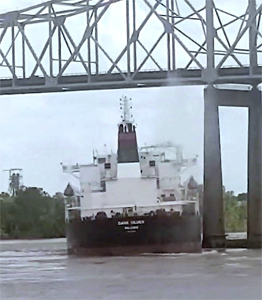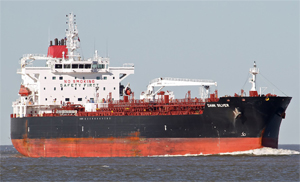Dank Silver loaded clean product at a refinery near Donaldsonville, La., and prepared to sail down the Lower Mississippi River to the Gulf of Mexico. Getting there meant coming off the dock and spinning 180 degrees in the swollen, fast-moving current.
A pilot from the New Orleans-Baton Rouge Steamship Pilots Association (NOBRA) was aboard to guide the 600-foot tanker downriver. He had completed similar jobs from the same refinery dock at least 10 times in his 14-year career, some during high water.
This one didn’t go as planned. The ship became caught in the 5- to 6-knot current and struck a support pier for the Sunshine Bridge about a mile downriver from the refinery. The impact occurred at 1322 on June 16, 2019, with total damage to the ship and bridge exceeding $4.5 million. No pollution or injuries were reported.
Investigators from the National Transportation Safety Board (NTSB) suggested the NOBRA pilot never gained full control of Dank Silver when starting to head downriver.
“Ultimately, because the pilot decided to turn the ship immediately off the dock rather than heading upriver to turn, he had less distance to gain control of the movement of the ship above the bridge,” the NTSB said in its accident report.
The NOBRA pilots declined to comment on the agency’s findings.
The Marshall Islands-flagged Dank Silver arrived at the Shell Convent refinery (formerly Motiva refinery) on June 13 to load refined products from berth No. 2. The Lower Mississippi was in a period of prolonged high water. The river gauge at Donaldsonville, six miles upriver, measured 31.3 feet — well above the flood stage of 27 feet.
The pilot boarded the ship at 1212 on June 16 and began the standard master-to-pilot exchange. The pilot later told investigators he intended to pass under the 750-foot-wide channel span of the Sunshine Bridge eight-tenths of a mile downriver.
The ship’s voyage data recorder (VDR) caught much of the dialogue between the master and pilot. However, investigators could not locate discussion about the intended path under the bridge. The ship’s trackline data appeared to confirm the pilot’s account, the NTSB said.
Given the high water and fast current, the 6,000-hp conventional tug Crosby Crusader and 4,200-hp conventional tug Ned Ferry held Dank Silver against the terminal during loading. The 5,200-hp z-drive tug Point Clear relieved Crosby Crusader before departure, taking position at the tanker’s port bow. Ned Ferry stayed at the port quarter but never got a line onto the ship.
 |
|
A cellphone photo posted on social media shows the tanker striking a support pier on the Sunshine Bridge near Donaldsonville, La., on June 16, 2019. |
|
Courtesy Facebook |
At 1242, before Dank Silver got underway, Point Clear’s captain asked whether the pilot planned to bring the ship upriver before turning 180 degrees. “Negative,” the pilot responded, according to the report. “We’ll go right here.”
The last lines let go about 30 minutes later, and the pilot issued a series of engine and rudder commands intended to turn the ship around. At 1313, records show the ship turning counterclockwise to port and moving 3.5 knots over ground.
Point Clear remained at the bow to help turn the ship. The tug’s 70-ton bollard pull exceeded the 55-ton limit on the ship’s bitts and chocks. As such, the tug could back at no more than two-thirds power during the evolution.
Dank Silver gained speed as it moved downriver toward the bridge. The pilot issued a steady stream of engine and rudder orders but soon recognized the ship was caught in the current. The ship sounded its whistle continuously in the minute leading up to impact with the bridge fender at 1322.
The bridge required $3.5 million in repairs, mostly to the fender system, while Dank Silver sustained damage to its hull plating and internal framing. The exterior hull breached at one of the ballast tanks. Ship repairs totaled about $1 million.
Investigators highlighted the pilot’s decision not to sail upriver before turning around. The NTSB reviewed six recent undocking maneuvers by ships of similar size and draft, from the same berth, in high water conditions. They found in every case that the pilots ordered the ships to head upriver between 0.15 miles and 0.56 miles before starting their rotation.
“All the vessels used three tugs to come off the dock and turn around, and the tugs used in these maneuvers had combined horsepower ranging from 11,020 to 13,200,” the NTSB reported. “The two tugs used by Dank Silver had a combined horsepower of only 9,400, and one tug was operating at reduced power.”
The report said reduced power from Point Clear at the bow “reduced the speed that the tanker could be turned, so the near 180-degree turn required to head downriver took longer to complete than if the pilot had used another tug in a different location to provide more force to turn the ship faster.”
The 3-year-old Dank Silver, operated by Oman Shipping Co., anchored downriver at mile 146.5 after hitting the bridge pier. The vessel underwent temporary repairs at anchor, then continued to Montreal to offload its cargo.

